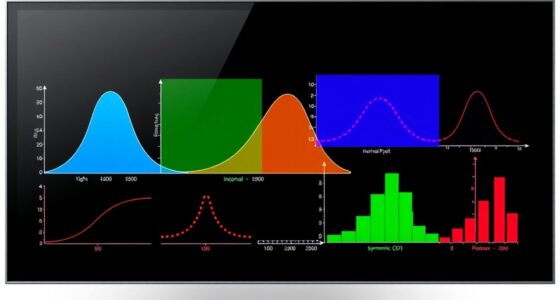The Law of Large Numbers shows that when you collect more data, your results become more stable and closer to the true chances of an event occurring. For example, flipping a coin many times makes the proportion of heads and tails even out. Small samples can be misleading, but larger ones reduce randomness and give you a clearer picture. Keep exploring, and you’ll discover how this principle builds trust in your findings and predictions.
Key Takeaways
- The Law of Large Numbers states that as sample size increases, the average result gets closer to the true probability.
- Small samples can fluctuate widely, but large samples tend to reflect the actual likelihood of outcomes.
- Increasing data points reduces randomness and makes results more stable and reliable.
- It explains why big studies or surveys produce more accurate and consistent estimates.
- Over many trials, outcomes stabilize and become predictable, confirming the law’s core idea.

Have you ever wondered why flipping a coin many times tends to produce nearly half heads and half tails? It’s because, over a large number of trials, the outcomes start to reflect the true probability of each result. This concept is at the heart of the law of large numbers, which explains how the relative frequencies of outcomes become more stable as your sample size grows. When you flip a coin just a few times, you might get a streak of heads or tails, but as you increase the number of flips, the results tend to even out. That’s because probability stability kicks in: the proportion of heads and tails approaches the actual probability, which is 50% for a fair coin. This phenomenon isn’t just about coins; it applies broadly to any random event with a fixed probability.
The law of large numbers essentially guarantees that, with enough data, your sample will accurately reflect the true likelihood of each outcome. This is where sampling accuracy becomes vital. If you only flip the coin a handful of times, your observed results might deviate considerably from the expected 50%. But as you increase the number of flips, the variation diminishes, and your sample becomes a more precise representation of the underlying probability. It’s like zooming in on a blurry picture; the more data you gather, the clearer the image becomes. That’s why statisticians rely on large samples to make accurate predictions and conclusions—because larger samples reduce the impact of random fluctuations. Additionally, larger samples help mitigate the effects of sampling variability and improve the reliability of your results.
Understanding this principle helps you see why large datasets are so valuable in research and decision-making. If you’re trying to estimate the average height of a population, for example, measuring just a few people can lead to misleading results. But measuring hundreds or thousands provides a more reliable estimate, thanks to the law of large numbers. It’s not just about getting close to the true value; it’s also about the confidence you gain in your estimates. As the sample size increases, the probability that your result is close to the true value becomes higher, ensuring more consistent and trustworthy outcomes.
In essence, the law of large numbers shows that randomness becomes less influential as your sample size grows. This is why probability stabilizes and sampling accuracy improves with more data. Whether flipping coins, conducting surveys, or analyzing financial markets, understanding this principle helps you grasp why larger samples lead to more predictable, stable results. So next time you hear about a big study or a large dataset, remember—it’s the law of large numbers working behind the scenes to give you more reliable insights.
Frequently Asked Questions
How Does the Law of Large Numbers Apply to Real-World Gambling?
In real-world gambling, you can see the law of large numbers in action through casino strategies and betting odds. As you place more bets, the actual results tend to align with the expected probabilities, reducing long-term variance. This means that while you might experience short-term wins or losses, over time, your results will likely approach the casino’s edge, highlighting why understanding betting odds is essential for informed decision-making.
What Are Common Misconceptions About the Law of Large Numbers?
You might believe misconceptions myths, like thinking the law guarantees short-term success or that it applies to individual outcomes. The frequency fallacy is common, where people assume results must balance out quickly. In reality, the law only works over many trials, not after a few. You should understand that it explains long-term trends, not immediate results, preventing you from falling for false expectations or overconfidence in short-term gambling.
How Does Sample Size Influence the Accuracy of Probability Estimates?
You should know that larger sample sizes reduce sample variability, making your probability estimates more accurate. When your data set is small, the results can be skewed or unreliable because of higher variability. As you increase the sample size, you improve data reliability, ensuring your estimates better reflect the true probability. So, bigger samples help you make more confident, consistent predictions by minimizing randomness and variability.
Can the Law of Large Numbers Predict Individual Outcomes?
You might wonder if the law can predict individual outcomes, but it’s not designed for that. It focuses on collective, long-term trends, reducing unpredictability in outcomes across large groups. Personal events remain uncertain and can’t be reliably forecasted by this law. Instead, it’s better suited for understanding probabilities in big samples, where patterns emerge over time, not for predicting specific, individual results.
How Is the Law of Large Numbers Used in Insurance and Finance?
In insurance and finance, you use the law of large numbers to improve risk assessment and guide statistical modeling. It helps you predict average outcomes by analyzing large data sets, reducing uncertainty for individual events. This way, you can set premiums or interest rates more accurately, ensuring financial stability. Fundamentally, the law allows you to rely on collective data, making your predictions more reliable and informed.
Conclusion
So, now you see how the law of large numbers works, just like a seasoned gambler hitting the jackpot after many spins. Remember, even in a world full of chaos, patterns emerge when you look at enough data—think of it as your trusty abacus in the digital age. Keep this in mind next time you’re faced with uncertainty; patience and persistence are your best allies, much like waiting for the right vintage to enjoy a fine wine.










